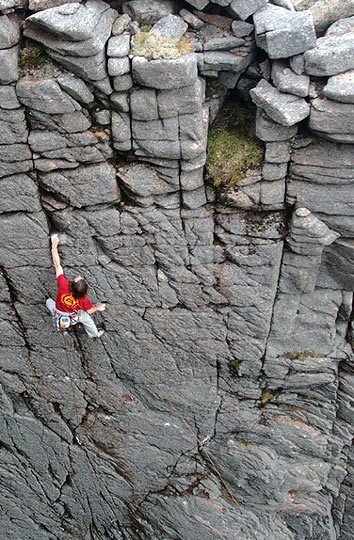
Dave MacLeod in the danger zone of To Hell and Back (E10 6c [5.13 X]), Hell?s Lum, Cairngorms, Scotland. Although “a fall from anywhere on the second half of pitch one is unlikely to be survivable,” MacLeod agreed to attempt the first ascent on live television. Weather precluded a live ascent, but he returned the next week, with a smaller TV crew, to finish the project. [Photo] Courtesty of Dave MacLeod
In the October 24 installment of its series “The Great Climb,” BBC Scotland aired coverage of Dave MacLeod’s August 23 first ascent of To Hell and Back, a hard, scantly protected, two-pitch traditional route in the UK’s Cairngorm mountains. The program featured tenuous footage of the Scotsman sending the line, which received the intimidating grade E10 6c (5.13 X).
MacLeod, perhaps most famous for authoring Rhapsody (E11 7a [5.14 X]), one of the hardest traditional routes in the world, initially backed down from attempting To Hell and Back for live TV cameras under poor weather conditions. “The temperature and humidity must be right, the build up must be right, the social vibe must be right, the resting times must be right. If anything upsets the necessary rhythm of preparation, I will have to make a cold decision to pass up the opportunity,” MacLeod told the BBC. According to his blog, “Falling off from the crux or above would have meant death.”
MacLeod sent the route the following week with a downsized BBC film crew remaining to capture the event. Producer Richard Else called the footage “an intimate and frightening portrait of the consequences of one of the world’s best climbers becoming obsessed with a new route,” on the BBC’s website.
The new 80-meter line in Hell’s Lum, bordering Scotland’s Loch Avon, features sections of both thin and slopey climbing with prolonged stretches of poor protection. It travels a “smooth, vertical wall,” crossing the existing Chariots of Fire and finishing around an arete, where it traverses an overhanging headwall to gain a “faint crack” to the finish, according to MacLeod’s blog. MacLeod sent the route with two belayers, one to pull some of the climb’s more suspect protection in an ideal direction; the other, his wife, to jump off the belay ledge, taking in as much slack as possible during a potentially terminal fall.
Retrospectively, MacLeod expressed mixed feelings regarding his ascent of To Hell and Back, referencing a combination of the television production’s immediacy and the inherent insecurity of the climb. “Yesterday was the scariest day of my life,” he blogged. “The impending lead of my “Great Climb” project on Hell’s Lum crag was hanging over me like a guillotine. It’s the most dangerous lead I’ve ever done, and right now, I’m not sure exactly how I feel about it… In the moment of the lead, I screamed at myself twice at the top of my voice because the reality hit me of where I was and what I was doing.”
During the past six months, climbing has been “all but ubiquitous” on British television, John Horscroft editorialized in the latest edition of Climber, and MacLeod’s X-rated climb was the “most ambitious of all.”
“What we never see in documentaries like To Hell and Back is the flip side of risk; not taking enough risk,” MacLeod said, “and missing out on doing something amazing with your life.”